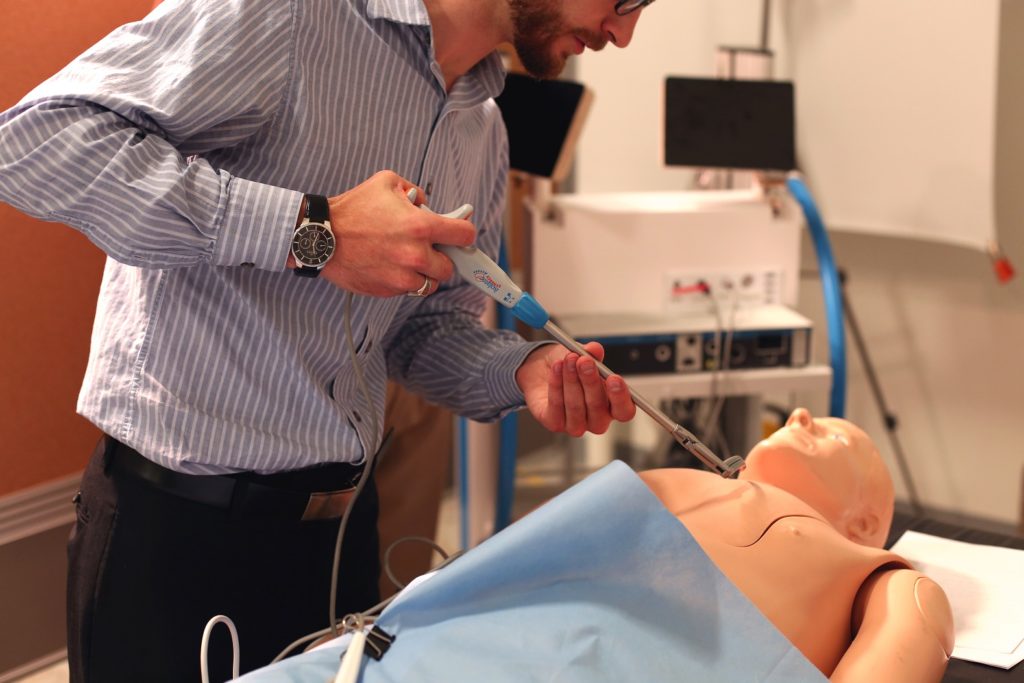
In the world of surgical device development, identifying needs first and testing concepts second is the key to user adoption and gaining a competitive advantage. This approach serves as the foundation to innovating smartly, along with quick, efficient, and robust methods of concepting.
At Kablooe Design, we include Design thinking early on in the process, which minimizes rework and aids in hitting cost and schedule targets. Let’s explore a few best practices for implementing this thinking into your surgical robotic design and development efforts.
COMBINE LINEAR THINKING WITH SCATTERED CHAOS
The brain is a wonderful thing—it’s very magical (right brain), but it’s also very methodical (left brain). Your left brain includes all your professional training and deals with cause and effect, linked thoughts, series of events, etc. Across the corpus callosum is your right brain, which is in charge of your creative problem solving, brainstorming, and random associations.
While many people think they have a dominant side, in reality, that’s not the case. It’s all about how you exercise it, and what types of activities you put in front of your brain. In order to push medical device innovation forward, you need both sides of the brain to work in tandem. Unfortunately, most of us haven’t been trained how to do that.
In fact, most of us have been trained not to do that.
Sir Ken Robinson, Chair of the UK Government’s report on creativity, education, and the economy, discusses a 24-year study that followed a group of students from kindergarten to college. He found that—contrary to popular belief—young people lost their ability to think in “divergent or non-linear ways,” which is a key component of creativity.
“Every child is an artist. The problem is how to remain an artist once we grow up”
Pablo Picasso
His study concluded that at the age of four, 98% of the students were able to demonstrate divergent thinking, or as we like to call it at Kablooe, scattered chaos. By the age of nine, that number shrunk to 32%. At 14, it was only 10%. Once the group of students reached the age of 21, only 2% retained their “divergent” creative problem-solving ability.
Why is this relevant to us as innovators, designers, and engineers?
Well, quite frankly, creative problem solving is instrumental in successful surgical robotics design. This means that not only do we need to be highly trained linear thinkers, but we also need to be effective and divergent wranglers of scattered chaos.
CREATE A DESIGN THAT SATISFIES ALL 8 UNIVERSAL JOB STEPS
Every device—surgical and otherwise—exists to perform a specific job. When it comes to actually designing those devices, you need to look at what’s known as the Eight Universal Job Steps. That’s because—whatever the device—every user will go through these steps in some capacity.
The 8 Universal Job Steps of Design Research:
- Define: Do I need a pencil?
- Locate: I need to go find a pencil.
- Prepare: I should check to make sure the lead isn’t broken.
- Confirm: I test that it works by scribbling on the paper and trying the eraser.
- Execute: I use the pencil to write what I need to write.
- Monitor: Do I need to erase something? My eraser is gone.
- Modify: I need to get a new eraser and stick it on the end.
- Conclude: I finish my work and go put the pencil away.
Unfortunately, most design engineers only pay attention to the fifth step. That makes sense, of course, since observing the user actually using the device is incredibly helpful. The problem is that you’re missing out on all of the other crucial steps leading up to and following that use.
Your customers can’t tell you what to make, they can only tell you how they feel. That’s the thinking you have to go through. In the words of the legendary industrialist Henry Ford:
“If I would have done what my customers asked for, I would have made a faster horse.”
Henry Ford
If you know that every user is going through these eight steps every time they use a device, wouldn’t you want to plan your design to satisfy everything that needs to happen for the user at each step? You would!
So go out, observe, record, and do a deep dive into the user’s world. Ask yourself what’s going on? What’s working for the user? What isn’t working? What’s challenging?
Ask the right questions, and you just might find the inspiration you’re looking for.
OTHER LESSONS LEARNED AFTER DECADES OF SURGICAL ROBOTICS DESIGN
Before we conclude, we wanted to leave you with a few miscellaneous bits of advice on designing surgical robots.
1. Small things work great in 3D CAD, but not always in real life
When you’re working on something really tiny—like an end effector for a surgical robotic device that’s going to enter a small space in the human tissue—you absolutely have to do a real-world comparison. If you rely too heavily on a CAD design, it might look like everything is rotating fine, but in reality, it will put too much force on the part. Start prototyping as early as you can to bring your loftiest ideas down to reality.
2. Durability is hard to design compared to fingers holding a scalpel
If the surgical standard is a physician holding a scalpel, then your design certainly has an uphill battle. Human fingers can do a lot of things: they’re cushioned, they rotate easily, they’re durable, and they can give immediate feedback on how hard they’re pressing. If you’re designing a tiny end effector for a robotic arm, every tolerance along the way needs to be just as small, nimble, and durable.
3. Figure out how to make the user feel empowered
Surgeons need to be empowered to do their jobs better. We certainly don’t want robotics to take away their decision-making ability, their autonomy to change their minds and adapt on the fly. Rather, you need to figure out a way to enhance those abilities.
4. Get inspiration from adjacent industries
There are only so many insights to be gained from studying other medical devices, so why limit yourself to only one pool of knowledge? Broaden your research to include other, less related industries such as agriculture, manufacturing, and military. You’d be surprised how much you can learn just from watching a warehouse fulfillment robot work for an hour or two.
FINAL THOUGHTS ON SURGICAL ROBOTICS DESIGN
Want to know the #1 rule for designing surgical robots? It’s simple—understand the user, their needs, and the problem that has to be solved. Then all you need to do is make sure your design is manufacturable, durable, and can function as intended.
To do that, you’ll need to use both sides of your brain, consider every step for user success, and remember that robustness and empowerment are key. If you do those things, you’ll be on a very good path to creative innovation in surgical robotics design.
Kablooe Design is a full-service product development company that specializes in developing new products for the medical device and consumer markets. Our unique staffing approach and D3 Process set us apart as a product development partner and give you peace of mind knowing that your product will be designed with all stakeholders in mind.
Whether you are building a brand new technology to disrupt the market or just planning a simple update to a current product, we have the resources and experience necessary to make your project a life-changing reality. Contact us today to get started.

